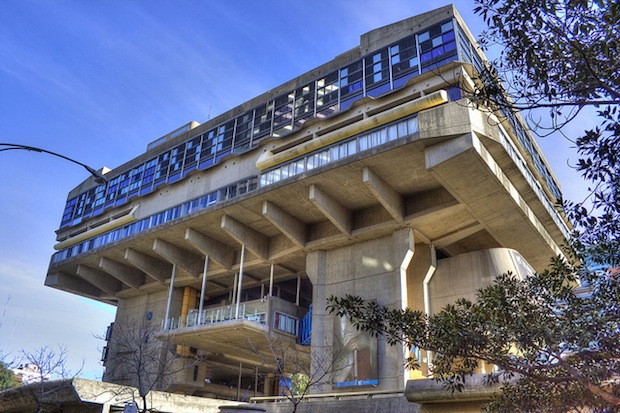The legacy of Argentine architect Clorindo Testa, 1923-2013


BUENOS AIRES -- Argentina's capital is famous for the Belle Époque French-style buildings that dominate its center and give it the nickname of the "Paris of South America." But it was also home to a mid-century boom in the kind of "Brutalist" architecture made famous by Le Corbusier, and the contrast between plain Brutalist exposed cement and French ornamental stucco and ironwork is the tension that defines downtown Buenos Aires today.
While many architects participated in the Brutalist boom, the city's two most famous buildings in that style -- the National Library and the Bank of London and South America -- were designed by the doyen of Argentina's architects, the recently deceased Clorindo Testa.
View the Clorindo Testa photo gallery on SmartPlanet.
Born in Naples in 1923, Testa came to Buenos Aires as a small child and, in 1948, was part of one of the first graduating classes of the architecture department at the University of Buenos Aires. A sculpter and painter as well as an architect, Testa then spent several years in Europe on a scholarship before returning to Argentina and winning his first design contest, at the age of 28, to build a headquarters for the Argentine builders trade group. Early on, he adopted the Swiss/French architect Le Corbusier as a philosophical inspiration. During post-World War II economic turmoil in Europe, inexpensive cement became the material of choice, and Le Corbusier combined it with his "Five Points of Architecture," which included long horizontal windows to equalize lighting, the use of reinforced concrete columns to remove the need for supporting walls, and non-structural façades.
In 1959, along with the SEPRA architecture studio, Testa won the contest to design the Buenos Aires headquarters for the Banco de Londres (Bank of London). Finished in 1966, the building is one of the best examples of Brutalist architecture of the era. Surrounded by a cheese-grater-like cement exoskeleton, the interior is full of huge open spaces unbroken by structural walls, and on the exposed, almost sculptural, cement, one can see the texture of the wooden forms used to cast it.
While Testa undoubtedly spoke the language of Brutalism, he did so with an Argentine accent, says Juan Fontana, an architect who worked with Testa for the last 24 years. Fontana, 57, notes that the building is more open to the outdoors than a typical European Brutalist building, in order to take advantage of Buenos Aires's abundant sunlight, and that the generous amount of space it leaves to the public on its street corner is an exaggeration of the usual Buenos Aires diagonally cut corner design.
"The Banco de Londres is a novel, contemporary response from a Buenos Aires architect. It may be spoken in the international language of Brutalism, but the space is very much of Buenos Aires," Fontana says. "Clorindo was trained in Buenos Aires, and this made him very Latin American in terms of how he saw space."
Just after winning the design competition for the Banco de Londres, Testa and several partners were chosen to design the country's new Biblioteca National (National Library) in 1961. Planted atop a hillside park, the tree-like library reflects and comments upon its natural surroundings. The huge cement building stores its books in an underground archive root system. When a book is ordered, it is sent up the thin middle trunk to the huge open reading room in the canopy-like top that looks over the nearby Río de la Plata (River Plate). Unlike the Bank of London, which was completed in 1966, the library took more than 30 years to build (and still does not have its planned window awnings) because of regular crises in Argentina's economy. Today, the library is in depressing shape -- a common complaint about the exposed cement of Brutalist buildings -- which Fontana also attributes to its state ownership and cultural reality.
"Latin American countries dedicate little of their budget to education, health and housing. And this is reflected in the buildings. Not only because there is no money. But because those in charge, and those who use the buildings, aren't educated," says Fontana. "Architecture is a cultural phenomenon."
In later years, Testa turned away from plain, unfinished cement and monumental size. He designed houses, such as the unfortunately demolished "Casa Di Tella" and "La Tumbona," a tumble of red boxes in the beach resort of Pinamar, as well as college buildings and oceanfront walkways. His designs became much more colorful and playful, like his artwork, and, Fontana says, his legacy is more of his personal vision funneled through Brutalism than it is Brutalism itself. Today, among other projects, Fontana and other members of Testa's studio are designing and preparing to install the original awnings planned for the National Library.
Testa died on April 11 at the age of 89.
Photos from Halloween HJB/Flickr; Laura Vescina/Flickr; Crippling/Tumblr; 33arquitectures/Tumblr; Raphael V/Flickr; Pruxo/Wikipedia.
This post was originally published on Smartplanet.com